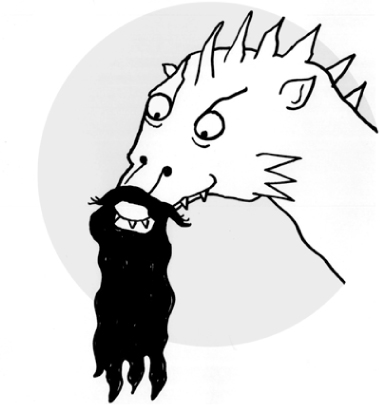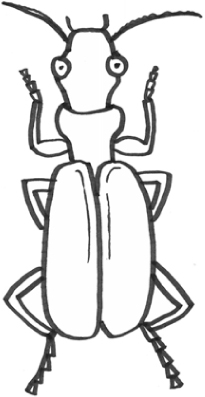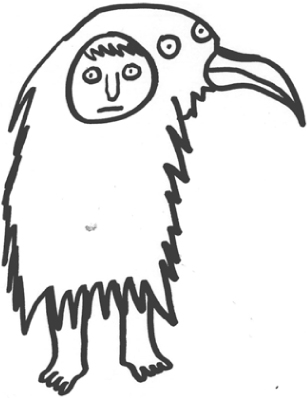CHAPTER 4
NORTHERN EXPOSURE

 Brain of Thrones
Brain of Thrones 
Here’s a curious thing: Hodor isn’t Hodor. His name is actually Wyllis. Well, in the A Song of Fire and Ice books he’s called Walder (possibly in homage to his family’s liege Lord Walder Frey) but he is Wyllis in the TV show (possibly in homage to the 1980s comedy favourite Diff’rent Strokes–‘What you talkin’ about Wyllis?’) Confused? It’s not surprising. The World of Ice and Fire echoes to the sound of an enigmatic character repeating the word ‘Hodor’ over and over and over again. As a result, almost everyone–be they book reader or television viewer–thinks that his name is Hodor. But they are wrong. It’s Wyllis. So, what’s going on? Why is Hodor–sorry, Wyllis–so fixated on this single word?
The answer may lie in some groundbreaking scientific research conducted over 150 years ago. In the 1860s, French surgeon Paul Broca was busy studying people’s brains, laying the foundations for modern-day neuroscience. During the course of his brainly experiments he came across a middle-aged man called Pierre with the strangest of speech impediments. Whenever Pierre tried to say anything, the only word that he could utter was ‘tan’. Unsurprisingly, everyone eventually came to refer to Pierre as ‘Tan’ in the same way that we all think of Wyllis as Hodor. This terrible condition affected many areas of Pierre’s life. At one point, for instance, he asked a decorator to paint his house and ended up with a series of monotonously mid-brown rooms. Just kidding. Anyway, when Pierre obligingly died, Broca cut open his skull, removed his brain and discovered damage on the left-hand side of his frontal lobes (or, as modern-day scientists snappily refer to the area, the ‘inferior frontal gyrus of the left cerebral hemisphere’). Over a century of subsequent work has proved a direct link between this area of the brain and speech production. Whenever the left frontal lobe area is damaged, people struggle to speak–which is why having a stroke on the right-hand side of the brain is generally much better news. And this area of the brain is now referred to as ‘Broca’s area’ in honour of the great Frenchman.

For a long time we were wondering what happened to Wyllis to cause his ‘hodoring’ behaviour. Perhaps he suffered a stroke or a tumour, or even a blow to the head? (Intriguingly, he does have a little scar on his head, but it’s on the right-hand side.) Extensive damage to Broca’s area is also sometimes caused by malnutrition, but that seems unlikely in Wyllis’s case, given his enormous girth. One thing is clear: Wyllis is clearly exhibiting a severe type of ‘expressive aphasia’. He can understand what other people are saying and respond, but he struggles to produce more than a single word.
Broca’s work paved the way for our current understanding of the brain. Before Broca had full access to Tan’s, sorry Pierre’s brain, most scientists were convinced that the brain worked as one big meaty lump to produce people’s thoughts, feelings and behaviour. Broca was convinced that this was not the case, and that each part of the brain was involved in a specific task. Discovering that damage to a tiny part of the left hemisphere severely disrupted speech production proved that he was right. In fact, this astonishingly simple idea underlies all of modern-day neuroscience, including all of those pretty brain scans showing the areas associated with vision, memory… and orgasms, and provided a crucial insight into what’s happening between your ears right now. Hodor? HODOR! Hodor… Hodor.
 Sneaky F*cker Strategy: The
Sneaky F*cker Strategy: The 
Surprising Secret of Samwell Tarly’s Success
Ah Samwell Tarly, aka Lady Piggy, aka Lord of Ham, aka Prince Porkchop; self-confessed coward, son and dispossessed heir of Lord Randyll Tarly of Horn Hill. Many of us Game of Thrones fans will have felt for this bookish, clumsy, chubby and socially inept character. His father is a powerful Westerosi lord–one of the Seven Kingdom’s noblest and most feared military minds, whose House words are ‘First in Battle’. But Sam (as he’s affectionately known) blew his right to great wealth and privilege by being hopeless at all things fighting-related. Hence he’s forced by his terrifying dad to join the Night’s Watch–the alternative being an even more sudden death in a hunting ‘accident’. And we all know how those go down (just ask the late King Robert of House Baratheon).
When we first meet Sam, he’s the frightened nerd being horribly bullied by the jocks. His new ‘brothers’ in the Night’s Watch are taunting him, calling him ‘Ser Piggy’. But it’s nothing new. He’s been shunned and shamed his whole life for lacking the traditionally macho skills that are prized in high-born young men of his ilk. His father has repeatedly tried and failed to turn Sam into the sort of alpha male heir he was expecting. Lord Tarly’s bid for Father of the Year previously involved dressing his son in women’s clothes, making him sleep in chainmail, and even enlisting the help of warlocks, who bathed him in aurochs’ blood. When all that failed, and his second son was born, Randyll Tarly seized his chance to offload the previous one to the ends of the Earth (the Wall) and forget he ever existed.
Despite this frankly terrible parenting Sam has remained a kind and thoughtful person, one who loves reading books and probably long walks along the beach. Amid the sea of troubled masculinity that is the Night’s Watch surging beyond the Wall, he’s thrown together with Gilly, a kind and resourceful wildling girl trying to save her baby boy. It’s apparent that she’s drawn to him and he’s drawn to her too–and well, we are cheering them on.
Of course, this is Game of Thrones, not your average rom-com. Gilly isn’t a quirky waitress with a heart of gold, or the slightly uptight owner of a downtown art gallery with a heart of stone, no Gilly is a traumatised wildling survivor of the hideous Craster’s daughter-marrying, son-sacrificing dynasty with I should imagine a rather brave, anxious lion-type of heart. Nevertheless, as Sam observes, the interesting thing about Gilly is that in spite of her abuse by grisly Craster, she remains optimistic about the future.
Sam’s sworn oath to the Night’s Watch should mean he is neither a fighter nor a lover. After solemnly taking his vows, including quite a big promise of celibacy, given his staggeringly obvious lack of skill with a sword, he’s assigned (relegated) to the administrative Steward’s division of the Watch. Yet, somehow, he manages not only to fall in love but also to have sex with Gilly, and to magnificently slay the White Walker who threatens his love and her baby son. Even before Gilly can read, she’s super-impressed by Sam’s knowledge and love of books–and what he can glean from marks on a page. She tells him he’s like a wizard (which he takes as a huge compliment, obviously).

So how does ‘unmanly’ Ser Piggy manage to stand out and get the girl amid the testy testosterone of the Night’s Watch? How does he succeed in an environment that is loaded against success for a young man like him? And can Sam and Gilly’s relationship progress?
Science may help us on this one. In particular, the findings of one of the 20th century’s most eminent evolutionary biologists, Professor John Maynard Smith, best-known for his theories on natural selection, and his research applying game theory (ideas originally developed to analyse poker and chess games) to the ‘game’ of being a living creature and getting what you want.
Before Smith came along, evolutionary biologists generally assumed that it was inevitable that natural selection prefers its males to fight their way to the top; that way, the dominant male gets the most chances to pass on his genes to the next generation. For surely the dominant males demonstrate their dominant-ness by doing super-masculine things, like hitting each other and sitting with their legs really far apart on public transport.
Smith realised that there may be more than one way for the fittest to survive and thrive and win the Game of Life. Like humans, animals will watch and try to interpret or predict the actions of others before they decide on a course of action. Thus Smith brought mathematics and probability into formulating and evaluating questions of behaviour in nature. And he argued that, rather than favouring one particular set of behaviours (aggressive dominance), natural selection tends towards maintaining a balance of differing characteristics within a species, so as to maximise the survival of at least some of said species when facing, for instance, a variety of circumstances or challenges in a difficult world. He dubbed this the ‘evolutionary stable strategy’.
The part of his thesis that feels custom-made for Samwell is the bit Smith called ‘Sneaky Fucker Strategy’, which explains why sometimes subordinate males get the girl. Put the term into a search engine, and Google helpfully offers ‘searches related to sneaky fucker strategy’: ‘sneaky male syndrome’ (OK, let’s call it that from now on), ‘kleptogamy’ (fancy way of saying the same thing) and ‘actor Clive Owen’ (er… what?). And surprisingly, at the time of writing, there isn’t even a specific entry for the strategy on Wikipedia–kingdom of the esoterically knowledgeable–which, possibly, indicates a conspiracy of silence from some of those who might well be expected to most benefit from said strategy…
The behaviour Smith describes is universally recognisable, however. In nature, the titular ‘sneaky male’ is observed waiting for his opportunity while the alpha males are off fighting, or showing off their prowess. Finding the coast clear, he chooses the moment to make his move on a female. And if she likes the look of him, they can mate while the non-sneaky fighting males are still earnestly scrapping over her.
What’s in it for the females? Well, research conducted with ‘sneaky male’ dung beetles show they often have ‘better’ genes to pass on to any joint offspring than the fighting males. They can also often be really off-the-cuff witty about the dung beetle equivalent of America’s Next Top Model.

In human groups, the ‘sneaky male’ may be the one who genuinely prefers the company and interests of the women around him to those of the men, or who just seems shyer and more sensitive and therefore attracts more potential partners to them. This highlights the radical theory that, for some women, pleasant attention is more enjoyable than being fought over. Imagine?!
So-called dominant alpha males may even be onto their rivals’ sneaky strategies. Writing about red deer stags contesting for hinds to add to their harems, Richard Dawkins and John Krebs describe the relative rarity of stags going against each other with antlers on full beam, as it’s easy for one or both to become injured, and also because ‘subordinate sneaky fucker males’ may slink off with hinds if a fight is prolonged.
Prolonged fights are still something of a house speciality in Game of Thrones, plus roaring at each other until your opponent backs down. But the unlikely blossoming of Sam and Gilly’s relationship gives us a tiny bit of hope in a world where there’s very little love or romance. (Unless of course you count Ser Jaime Lannister musing on the things he does in the name of his incestuous love for his sister Cersei, before casually defenestrating the innocent seven-year-old Bran Stark?) But we all hope to go through life finding and feeling love. It’s a basic human emotion. Even if it doesn’t work out, even if it wasn’t real, it’s gotta be worth something, right? Gilly and Sam are both warm-hearted and kind, but have both been abused and battered on their journeys through life, up until the point they find each other. And I hope you’ll agree, finding someone who loves you for you, and makes it so all the other things in life make sense, that’s the dream. (That’s what gets me out of bed in the late afternoon, anyway.)
So, will Gilly and Sam make it against all the odds? Well, this is Game of Thrones, so don’t buy your hat just yet. Sam may have easily disregarded some of his vows, but it’s hard to see how he can stay together with his lover. He tells Gilly he would prefer to marry her rather than any princess. But no dice, he’s in the Night’s Watch for life and disappointingly they’re all about ‘brothers before mothers’. Ho hum.
But equally, never underestimate the ‘sneaky’ ones. The pair may well be alive and prospering long after some of the more violent characters have competed themselves out of existence.
And it’s worth pointing out that at the end of A Dance with Dragons, we discover Sam may currently have The Horn of Winter, a fabled instrument that may magically protect or destroy the Wall: that icy barrier which right now is all that stands between the White Walker Others and the realms of men. Sam, who loves old things, even broken old things, is given the curio by Jon Snow after it turns up buried with a stash of dragonglass. Of course, it could just be an obsolete old warhorn, but if it is The Horn, well, combined with his Valyrian steel sword, Sam has potentially a pretty big role in the great battle of ice and fire to come, even without the greatest fighting fortitude.

 Skinchanging–
Skinchanging– 
Out of Body Experiences
Escaping from the flesh-and-blood prisons of our own bodies and effortlessly flying across a blue sky or running swiftly through a cool forest is something many of us have dreamed of, particularly during a bad hangover. But is an out-of-body experience possible? Can we ever be aware of our surroundings when not ‘in’ our own bodies? How do we truly know where we end and the rest of the world begins? And can we manipulate this knowledge?
In the world of Game of Thrones, the secret power of ‘skinchanging’ (or ‘warging’) is possessed by a chosen few. This is the ability to slip the bonds of your own body and enter and control another creature, seeing, smelling and feeling the world as it does. Those who practise this skill are called wargs–though strictly speaking (at least in the world of the books), ‘warging’ is the ability to change into a dog or a wolf, the beginner’s level in the difficult art of skinchanging, beyond which few progress.
Though a warg can skinchange with any living creature, it is important not to go rushing in but to take care choosing your animal. The wildling skinchanger Haggon sets out some general advice. Birds are to be avoided, due to the dangerously intoxicating sensation of flying–you’ll never want it to stop and will become a bird for ever and ever. (Then before you know it, your nest’s mortgaged to the hilt, you’re trying to get the chicks into a good local school–jeez, where’d the fun times go?) Forging a bond with a dog, or even a wolf, leads to a trusting warg-relationship that becomes more assured with time. Cats on the other hand really aren’t having any of it, so are best avoided, as you might imagine.
There are also rules–a sort of warging code of conduct–that Haggon lays out. It is taboo to eat human meat while in the body of another animal; you must avoid the awkward scenario of being inside another animal when it’s mating, and therefore possibly also inside another animal, as it all gets a bit Russian (sex) doll. And hey–two’s company, threes’s a crowd… But the worst warging crime of all is to try to control the mind of another human being, not least perhaps as it’s frighteningly reminiscent of the control exerted over the army of dead wights by the White Walkers (see here).
When Hodor is ‘warged’ by Bran, we witness this as a horrible transgression; Hodor tries to hide inside himself to get away. Bran is an extremely gifted warg but, morally, this is highly dubious.

George RR Martin has said that all the Stark children have the ability to warg ‘in their genes’, as it were. Bran, one of the younger Stark boys, begins to develop his ability after he falls from the tower and is unable to move around in his own body. He realises that the gift he has is both significant and problematic. Not many wargs have been born since magic fled the World of Ice and Fire–maybe less than one in a thousand children possesses the ability. But still, among the smallfolk of the northern kingdom, any child suspected of being a warg will be left out to die.
The freefolk, north of the Wall, value the skills of the wargs, but even wildlings keep their distance. For, as Old Nan used to say, as she whispered scary stories to Bran in the nursery at night, how do you know if the man is wearing the beast or the beast is wearing the man?
The idea of travelling into the bodies of other animals or humans may seem to have zero parallels in our world but, in fact, every year hundreds of people report ‘out of body experiences’ (OBEs), or astral trips, that typically involve the sensation of floating above one’s body, and often observing one’s body from a place outside it. While they don’t tend to involve ‘entering’ other people or animals, in some OBEs people even report leaving their body behind to visit other places and even other ‘dimensions’ before returning to themselves. Generally, the experience seems to be a very positive one, and some of those who have regular OBEs even learn to control their trip, and actively aim to get into the right state for it. Like warging, it seems to impart a sense of freedom and possibility to those who experience it.
The phenomenon has been much studied and some interesting results reported, but despite claims from some that they are able to leave their bodies at will, apparently no-one has managed to do so in a scientific setting in order to ‘prove’ their abilities by recalling or reporting specific information. For instance, subjects have not been able to identify objects previously placed on a high shelf that’s invisible from the ground, or outside the window on an otherwise inaccessible ledge. And as a result, so far, psychologists can’t agree that anything greater than chance has been demonstrated in the lab.
When it comes to ‘body swapping’, closer to warging of the show/ books, two researchers, Valeria I. Petkova and H. Henrik Ehrsson, made the stuff of fantasy literature (and Hollywood comedies) into a distinct area of scientific study with the help of some virtual reality headsets, mirrors and a mannequin.
In their 2008 paper entitled ‘If I Were You: Perceptual Illusion of Body Swapping’, Petkova and Ehrsson acknowledged the question of just how tenuous our hold on our own bodies and the space they occupy can be, by exploring the imaginative conundrum of suddenly finding yourself inside the body of another. (Yeah–again–not like that.)
Why do you think you’re inside your own body? Because you can see it? But what if you looked down and saw another body, utterly different from what you’re used to? If you could also touch that strange new body–and feel it being touched by others–then what? From neurological studies we’ve learned that damage affecting frontal, parietal and temporal lobes of the brain can make you feel like you’re outside of your own body, and there are illnesses that cause sufferers to fail to recognise their limbs as their own.
In order to better understand the processes that underlie these experiences, the researchers gave participants VR headsets that relayed all the visual information they received. And to trick the brain into accepting the ‘body swap’ from every angle, the participants were also initially touched on the torso while watching the mannequin with whom they were ‘body swapping’ being touched in an identical way.
Petkova and Ehrsson succeeded in creating the illusion of swapping bodies across genders–the mannequin appeared male, yet female subjects could still feel themselves inside ‘his’ body. They also achieved a measurable physiological response when the mannequin was threatened in some way. They even tricked participants into feeling as though they’d changed places with one of the researchers, and shaking hands with themselves. Ehrsson says this illusion is highly convincing: ‘The first time I experienced the body-swapping illusion with [fellow researcher Valeria Petkova] I almost started screaming because it was such a surreal and striking experience to shake hands with myself using a different body.’
Focusing on this apparently playful reversal, the paper sets out a response to ‘the fundamental question of why we have an ongoing experience of being located inside our bodies’–something which has preoccupied psychologists and philosophers for hundreds of years.
While warging offers an ultimate freedom from inside the walls of our own flesh and blood, experiments that show we can fool ourselves into believing inanimate objects are part of us, and how easily we can be tricked to not recognise our own bodies, remind us that our brains are constructing our sense of ourselves ‘from the inside’.
In a world that so often wants to categorise us according to how we look from the outside, experiments with the self-defined limits of our bodies can give us a new fluid vision of ourselves, free from other’s limiting views of our physicality and our body’s capabilities. Maybe in the future, if such technology can be used for entertainment, we’ll find ourselves with the same dilemma as the wargs: exhilarated by new experiences, but warned not to stay too long in case we never want to return to ourselves.
 Arya’s Revenge–A Dish
Arya’s Revenge–A Dish 
Best Served Cold by… No-one?
Many of us have a list that runs through our heads as we try to fall asleep at night. My list is stuff like ‘moisturise shins’ and ‘stop buying candles shaped like animals’; yours will be different (almost certainly), but we’re all familiar with the idea of unfinished business at the end of the day. For Arya Stark, however, that list, the ‘prayer’ that insistently floats through her mind before sleep, is a recitation of the names of those who have killed and abused her family and friends. We watch Arya grow from a nine-year-old tearaway who rejects playing at being a lady in favour of fighting and shooting arrows, to an accomplished killer, fuelled by grief, anger and hatred.
Diagnosing fictional characters can be tricky, but it seems safe to say that after watching her father’s execution and losing so many of her loved ones, Arya is suffering from post traumatic stress disorder. Like some real-life sufferers, she turns to revenge fantasies as a coping strategy to deal with her feelings of helplessness and rage. She decides to train as a professional assassin. And she’s still barely into her teenage years. Written down in black and white this is pretty devastating, yet somehow Arya is one of the most lovable characters in Game of Thrones.
She desperately wants to find the place she belongs, and the people she belongs with. Ever the wolf-child, she thinks of them as her ‘pack’. She remembers her father’s words–he tells her not to be too independent, because when winter comes the lone wolf dies, but the pack survives. And we really, really want Arya to find her pack and to be safe. (‘Please not Arya. Please not the dire wolves!’ goes my mantra at the beginning of any episode of the TV show where they might be in danger of dying or related horrors; like a sort of reversal of Arya’s own prayer.)
We watch Arya go through various transformations to safely hide her original identity as a ‘highborn young lady’. She loses herself among the ‘smallfolk’, begging and serving, while all the while becoming a better and better fighter. She loses her sight for a while as bent on revenge, she trains to become an assassin with the Faceless Men–and we remember Ghandi’s ‘an eye for an eye makes the whole world blind’.
To serve the Many Faced God with the Faceless Men, Arya must put away her House and her name and become ‘no-one’; she must have no identity, and yet it seems that all she has left of her original identity is her ‘kill’ list, and her little sword, Needle–both of which she fiercely clings to.
Not long before Arya arrives at the House of Black and White to train with the Faceless Men for a career as a dispassionate killer (which, to be fair, in the brutal circumstances of the world of Game of Thrones, does seem to be what any Westerosi careers counsellor might advise for her), she has the chance to cross one of the names off her list.
The Hound, Sandor Clegane, has long served Joffrey and the Lannisters and he kills Arya’s friend Myca without a second thought, when they tell him to do so. Onto Arya’s list he goes. But then The Hound captures a runaway Arya, thinks of returning her to her family for some ransom, that er doesn’t work out, so the two of them are stuck travelling the Seven Kingdoms together. Arya says she hates him, promises to kill him and yet… she doesn’t. An unlikely respect develops between the two of them–affection between two birds of a feather, almost. So we see Arya choosing not to act on one of her revenge fantasies. Out of what? Compassion? Fellow feeling? Loneliness?
Brain-imaging scans can help scientists measure why we get so much pleasure from exacting revenge. Using a technology called positron emission tomography (or PET), Ernst Fehr, professor of Experimental Economic Research in Austria, studied activation in a region of the brain called the dorsal striatum–that’s the region involved in registering enjoyment and satisfaction. Fehr studied the emotional dynamics involved for participants in a game of exchanging money back and forth. When one participant made a selfish decision, another player could choose to punish him. And the majority of players elected to do so. The degree of activation of their dorsal striatum region corresponded with how far they were prepared to go. In some cases, volunteers decided to impose a penalty on a selfish wrongdoer even when it cost them some of their own money; those player-participants showed the greatest corresponding degree of activation in dorsal striatum, hence it seems the greatest satisfaction in righting a wrong.
But what about when you can’t pay someone back? Are revenge fantasies a healthy means of coping? Do they help us to regain some sense of control over past traumas, or could they lead to further negative consequences? The psychological impact of fantasising about revenge is less widely studied. One experiment incited participants to develop a thirst for revenge ‘after they scored low on a difficult anagram task’. Lustily oh oaf pry! (You’ll pay for this!)

More in keeping with our Game of Thrones-esque investigations is the study that looked at the occurrence and possible usefulness of fantasies of dishing out revenge as part of a therapy called ‘imagery rescripting’. This technique–also called ‘guided imagery’–is being used by psychologists to help patients suffering from depression or post traumatic stress disorder revisit or re-create difficult episodes from their past with the aim of updating them. The patient is asked to vividly recall or create a scenario with personal resonance from their past–for example, a time when they were a child and an adult belittled them. They can then enter the scene with the adult and answer back for their younger selves. And redress the balance. For some people this imaginary intervention will be a verbal reckoning. For others it will involve violence towards (in this case) the bad adult.
Psychologists pondered the implications of this. Was imaginary revenge a ‘safe’ place to go, or could it lead to worse things ahead?
A study published in the Journal of Behavior Therapy and Experimental Psychiatry looked at the psychological impact of trauma on mentally healthy participants with no previous history of violent behaviour. The paper’s authors created the effects of trauma in the participants by showing them five-minute clips from violent and disturbing Hollywood films where various protagonists were subjected to physical, emotional or sexual abuse. After they’d watched the clips, the participants were split into three groups to take part in different therapeutic exercises.
The first group had to imagine entering the scene they’d just watched and exacting a violent revenge on the perpetrator. The second group intervened in a non-violent way when they entered the scene. And the final group got to magically send the victim to a nice, safe location, like a beautiful beach.
What would make you feel better?
The next day, after they’d completed the exercises, all three groups still felt anger and sadness when they looked at images of the violent perpetrators from the film clips they’d watched. But those who had been violent in their fantasy didn’t show higher levels of violent feelings than those who had merely verbally dished out revenge. Though it was noted that the violent revenge sparked more joy for participants than the other two options, the happiest of all were those who had been able to take the victim away to a safe place without saying a word or lifting a fist.
The research results were interesting, if not conclusive (they were dealing with fantasy revenge of fantasy wrongs after all). They seem to indicate that revenge fantasies can be beneficial, or at least not necessarily damaging, so psychologists don’t necessarily need to fear someone starting down an Arya-ish road. So, until we invent the ‘save them and send them to a beach device’, let’s not feel too bad fantasising about revenge, while also hoping that the day soon comes when Arya and those like her find their packs.
